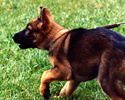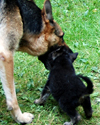History of the Dog
Dog Behavior
Our dog training and behavior methodology is based on a deep understanding of natural canine behavior and its practical application. Key to success is helping the owner understand why his/her dog is behaving, or "misbehaving" and what they can do to change that behavior for the long run.
Who is the Dog?

Man's Best Friend
Is Not a Furry Little Man
Thirty-eight species, including the domestic dog (Canis familiaris), make up a group of carnivores called the Canid or Canidae. Most cientific evidence indicates that all dogs were domesticated from the wolf (Canis lupus) around ten thousand years ago.
The dog, like man, is a highly social, polymorphic animal. We both develop relationships with other members of our species to form social structures or societies. Yet, both the dog and man show a great deal of variety in our individual behaviors and physical appearances. In a highly adaptive species, this dichotomy is logical--the diverse skills of the individuals benefit the society as a whole.
"It would be theoretically advantageous for a wolf pack to be behaviorally polymorphic: to have one member which would be highly timid and react to the slightest suspicion of danger and thus keep the pack on the alert, and another which might be bold enough to go in and obtain food when danger was slight and the need for food great." (Scott & Fuller: Genetics and the Social Behavior of the dog. P83)
A Wolf in Dog's Clothing

We Need to
Speak Their Language
Despite having lived with humans for thousands of years, a dog is not a four-legged human dressed in fur. We may form relationships that resemble a human family or wolf pack, but we are different species with different natural behaviors. When we treat our four-legged friends as little humans, we invite behavior problems. To best care for our dog, we must understand what it is to be a dog, in fact, what it is to be a wolf.
A behavior pattern is a set of actions combined for a single purpose, such as grooming. There are twelve behavior patterns identified in the family Canidae to which the dog and the wolf belong.
Additionally, some behavior patterns are closely associated with others in loose relationships called behavioral systems. For example, the investigative behavior pattern is combined with agnostic and ingestive behavior patterns to form a behavioral system whose function is to capture and eat prey. We often call innate behavior, instinct.
What Happened to the Big, Bad Wolf?

Learn What Drives Them
As the wolf became increasingly associated with humans, we began to mold the wolf into a creature more habituated to man's wants and needs, eventually creating a new species. Our different tribes had different needs and thus we selected for some traits in one part of the world and entirely different ones in others.
Because our social groups were isolated by distance, language and culture, our dogs became specialists, increasingly different from their ancestor the wolf and increasingly different from one other.
Variety Is the Spice of Life
Across the various breeds, dogs show extreme variation in physical attributes--from the diminutive Chihuahua to the very large Wolfhound, from the flat-faced Pug to the elongated snout of the German Shepherd Dog.
We might conclude that dogs breeds exhibit a variety of unique behaviors as well. However, selection only modified existing behavior, diminishing some traits while exaggerating others. It did not create anything new or take anyting away. All dog breeds still maintain the same basic patterns of behavior as the wolf.
As trainers, this is great news because the behavior displayed by the playful Golden Retriever is driven by the same instinct as that of the focused Fox Terrier. We need only to be able to recognize the underlying behavior pattern to understand how to modify it. We don't have to learn a new set of bevhavior patterns for each breed.
My Dog Is One of a Kind

Understand what they need
If dog behavior is the same for all dogs, then why are dog breeds so different and individual dogs more different still? Man has had thousands of generations with which to experiment. In that time we have been able to, in certain breeds, diminish some traits to near extinction. For example, we have nearly eliminated the bark from the Basenji.
In others we have exaggerated a behavior to the point that it appears to be quite different than its underlying behavior pattern, for example, the amazing herding ability of the Border Collie. And yet even within a breed, individual dogs show great variety in type. We call this endearing trait, personality, and it's why the dog is man's best friend.
In Summary

Follow mom's lead
Each dog has a unique personality, each breed its own characteristic type, and all types are variations of a set of behavioral patterns that are common to all Canidea. By understanding the dog at each of these levels, we can create training methods that are based not only on the dog's instinct but are also tailored to the individual dog.
Call 203.232.8018 or email John to discuss how we can help you and your dog live happily ever after.
Breed Specific Behavior
The following links will take you to breed-specific pages. The pages are designed to help you, the dog owner, better understand your dog at the breed level. They are also to encourage the potential dog owner to fully investigate breed characteristics before acquiring a new dog. We have started with some of the most popular breeds in the United States as listed by the American Kennel Club and will continue to add to and update this section over time.
For recommended reading on dog behavior, view our listmania list at amazon.com.

